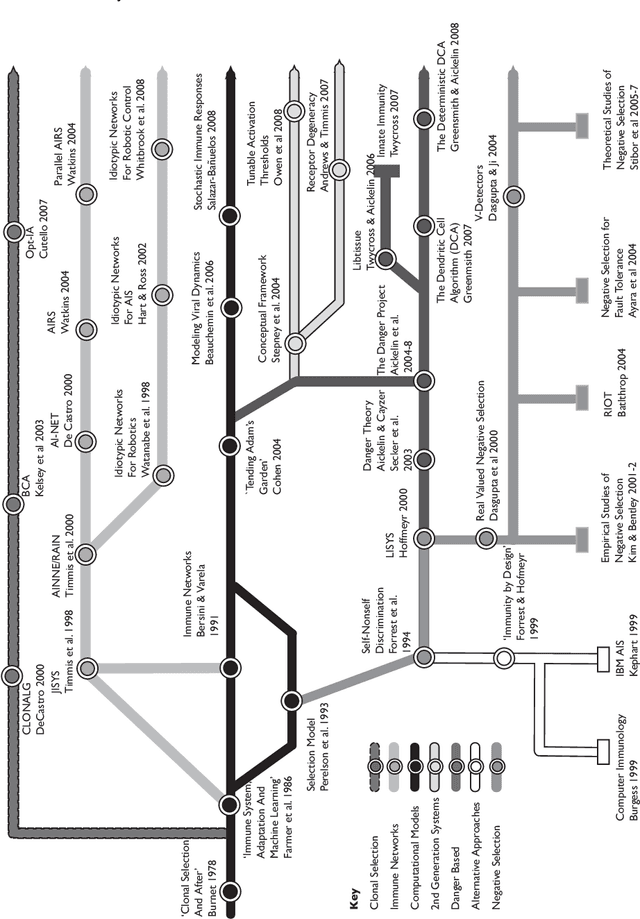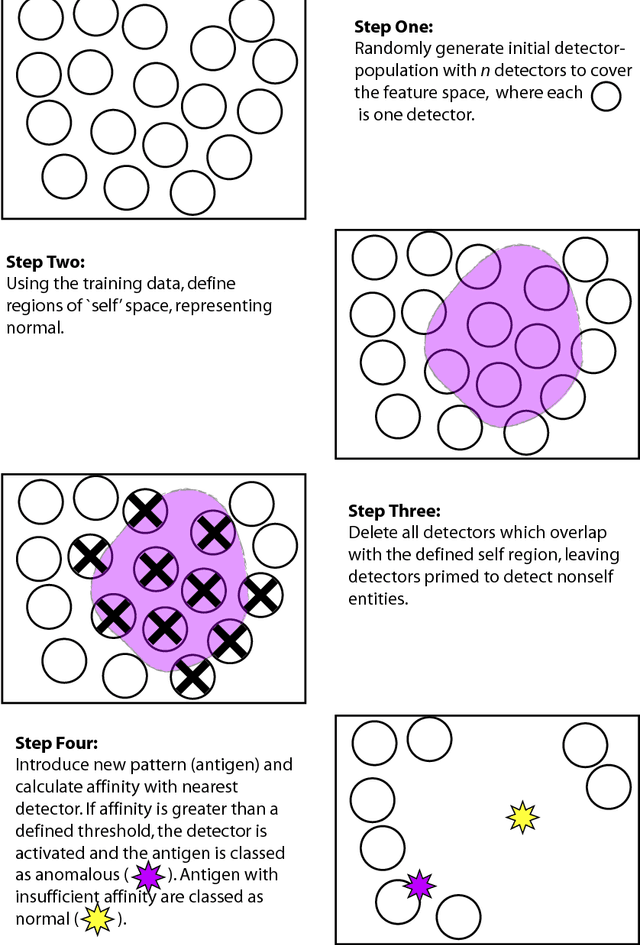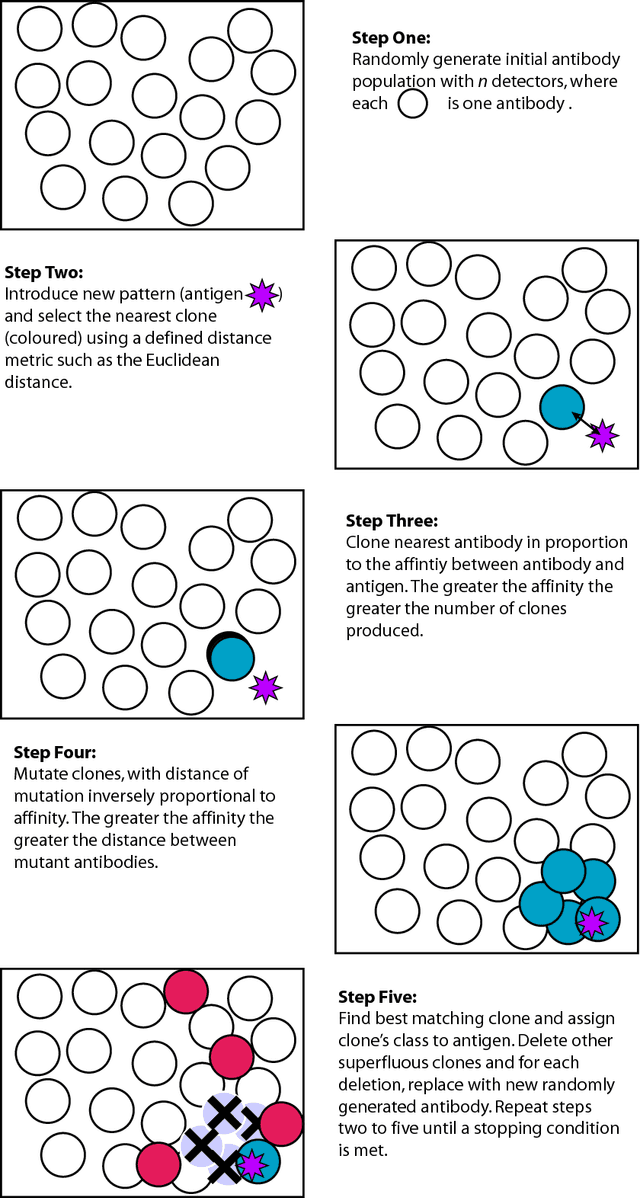Steve Cayzer
Detecting Danger: The Dendritic Cell Algorithm
Jun 25, 2010



Abstract:The Dendritic Cell Algorithm (DCA) is inspired by the function of the dendritic cells of the human immune system. In nature, dendritic cells are the intrusion detection agents of the human body, policing the tissue and organs for potential invaders in the form of pathogens. In this research, and abstract model of DC behaviour is developed and subsequently used to form an algorithm, the DCA. The abstraction process was facilitated through close collaboration with laboratory- based immunologists, who performed bespoke experiments, the results of which are used as an integral part of this algorithm. The DCA is a population based algorithm, with each agent in the system represented as an 'artificial DC'. Each DC has the ability to combine multiple data streams and can add context to data suspected as anomalous. In this chapter the abstraction process and details of the resultant algorithm are given. The algorithm is applied to numerous intrusion detection problems in computer security including the detection of port scans and botnets, where it has produced impressive results with relatively low rates of false positives.
* 27 pages, 8 figures, Robust Intelligent Systems
Introducing Dendritic Cells as a Novel Immune-Inspired Algorithm for Anomoly Detection
Apr 19, 2010



Abstract:Dendritic cells are antigen presenting cells that provide a vital link between the innate and adaptive immune system. Research into this family of cells has revealed that they perform the role of coordinating T-cell based immune responses, both reactive and for generating tolerance. We have derived an algorithm based on the functionality of these cells, and have used the signals and differentiation pathways to build a control mechanism for an artificial immune system. We present our algorithmic details in addition to some preliminary results, where the algorithm was applied for the purpose of anomaly detection. We hope that this algorithm will eventually become the key component within a large, distributed immune system, based on sound immunological concepts.
* 14 pages, 4 figures, 4 tables, 4th International Conference on Artificial Immune Systems (ICARIS2005)
The Danger Theory and Its Application to Artificial Immune Systems
May 16, 2008

Abstract:Over the last decade, a new idea challenging the classical self-non-self viewpoint has become popular amongst immunologists. It is called the Danger Theory. In this conceptual paper, we look at this theory from the perspective of Artificial Immune System practitioners. An overview of the Danger Theory is presented with particular emphasis on analogies in the Artificial Immune Systems world. A number of potential application areas are then used to provide a framing for a critical assessment of the concept, and its relevance for Artificial Immune Systems.
A Recommender System based on Idiotypic Artificial Immune Networks
May 16, 2008



Abstract:The immune system is a complex biological system with a highly distributed, adaptive and self-organising nature. This paper presents an Artificial Immune System (AIS) that exploits some of these characteristics and is applied to the task of film recommendation by Collaborative Filtering (CF). Natural evolution and in particular the immune system have not been designed for classical optimisation. However, for this problem, we are not interested in finding a single optimum. Rather we intend to identify a sub-set of good matches on which recommendations can be based. It is our hypothesis that an AIS built on two central aspects of the biological immune system will be an ideal candidate to achieve this: Antigen-antibody interaction for matching and idiotypic antibody-antibody interaction for diversity. Computational results are presented in support of this conjecture and compared to those found by other CF techniques.
On the Effects of Idiotypic Interactions for Recommendation Communities in Artificial Immune Systems
May 16, 2008



Abstract:It has previously been shown that a recommender based on immune system idiotypic principles can out perform one based on correlation alone. This paper reports the results of work in progress, where we undertake some investigations into the nature of this beneficial effect. The initial findings are that the immune system recommender tends to produce different neighbourhoods, and that the superior performance of this recommender is due partly to the different neighbourhoods, and partly to the way that the idiotypic effect is used to weight each neighbours recommendations.
Danger Theory: The Link between AIS and IDS?
May 16, 2008


Abstract:We present ideas about creating a next generation Intrusion Detection System based on the latest immunological theories. The central challenge with computer security is determining the difference between normal and potentially harmful activity. For half a century, developers have protected their systems by coding rules that identify and block specific events. However, the nature of current and future threats in conjunction with ever larger IT systems urgently requires the development of automated and adaptive defensive tools. A promising solution is emerging in the form of Artificial Immune Systems. The Human Immune System can detect and defend against harmful and previously unseen invaders, so can we not build a similar Intrusion Detection System for our computers.
 Add to Chrome
Add to Chrome Add to Firefox
Add to Firefox Add to Edge
Add to Edge